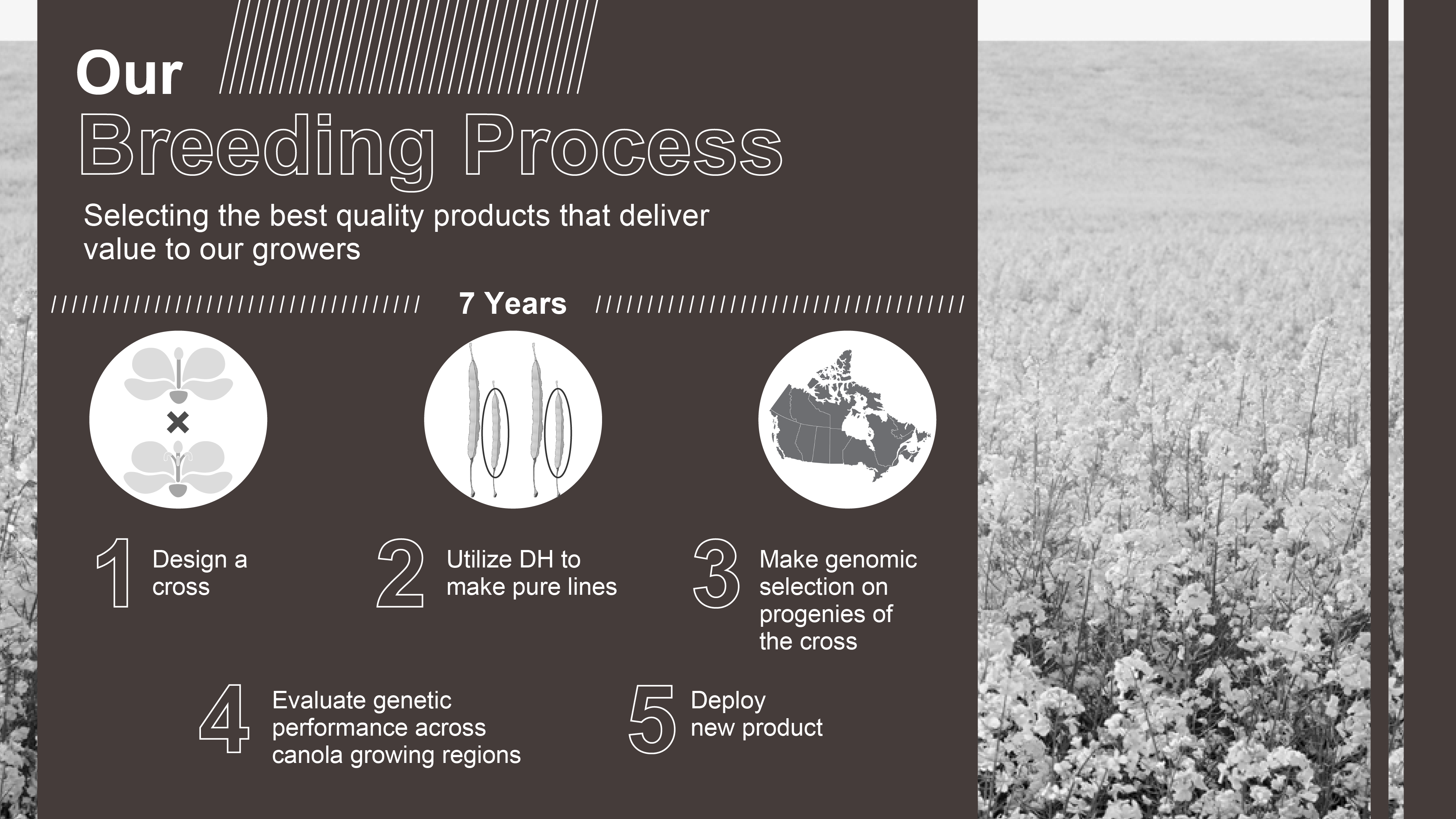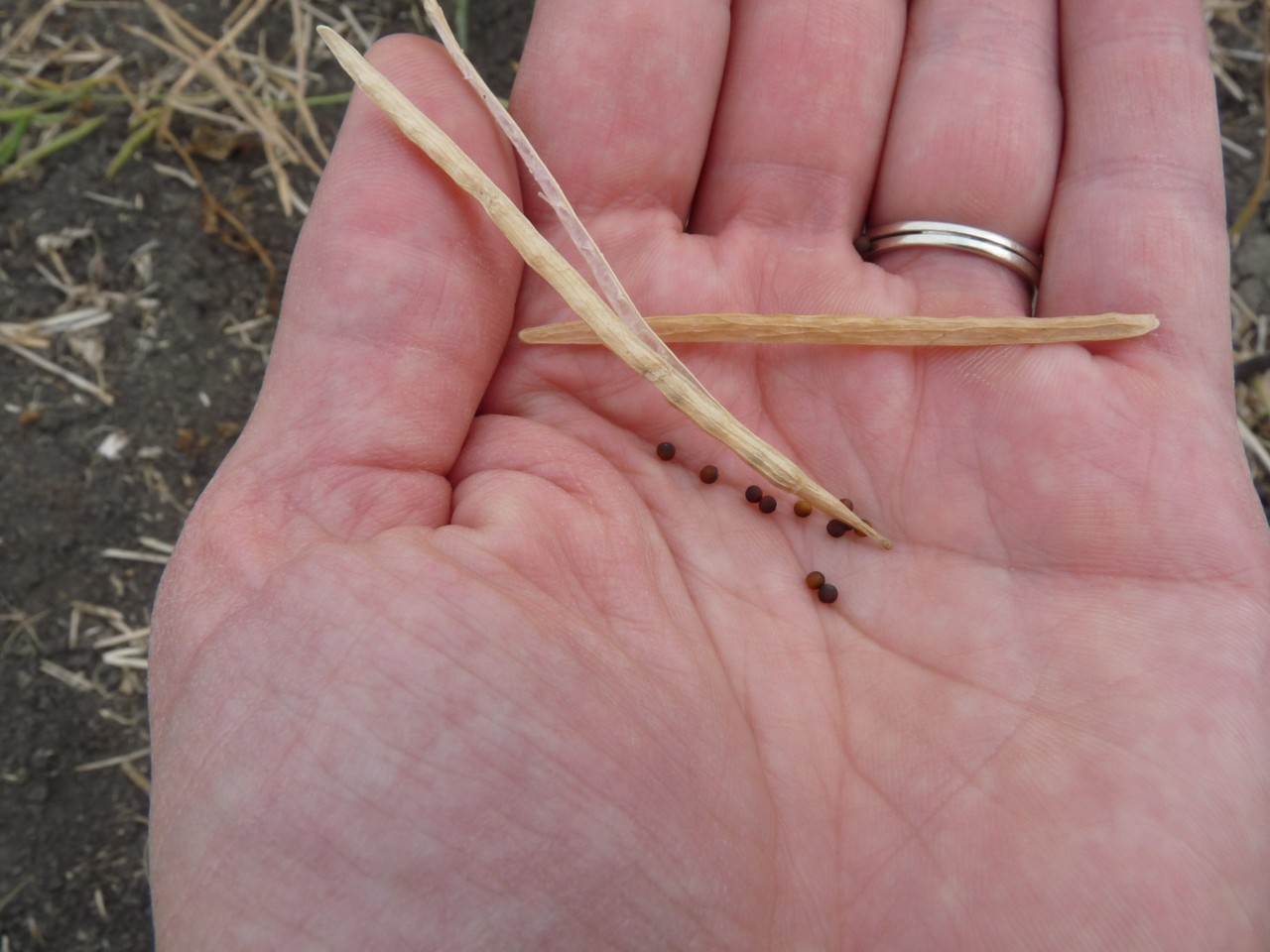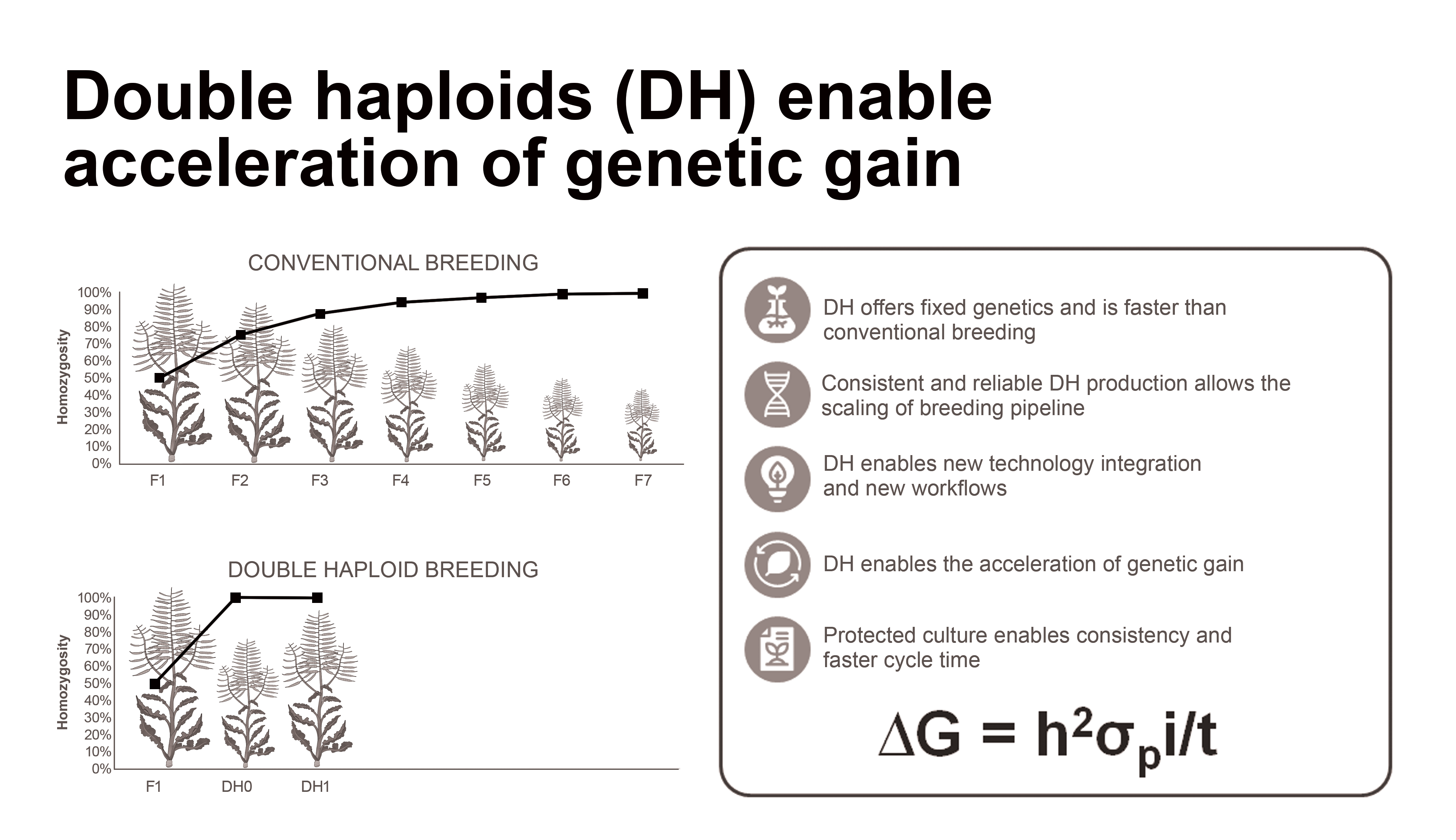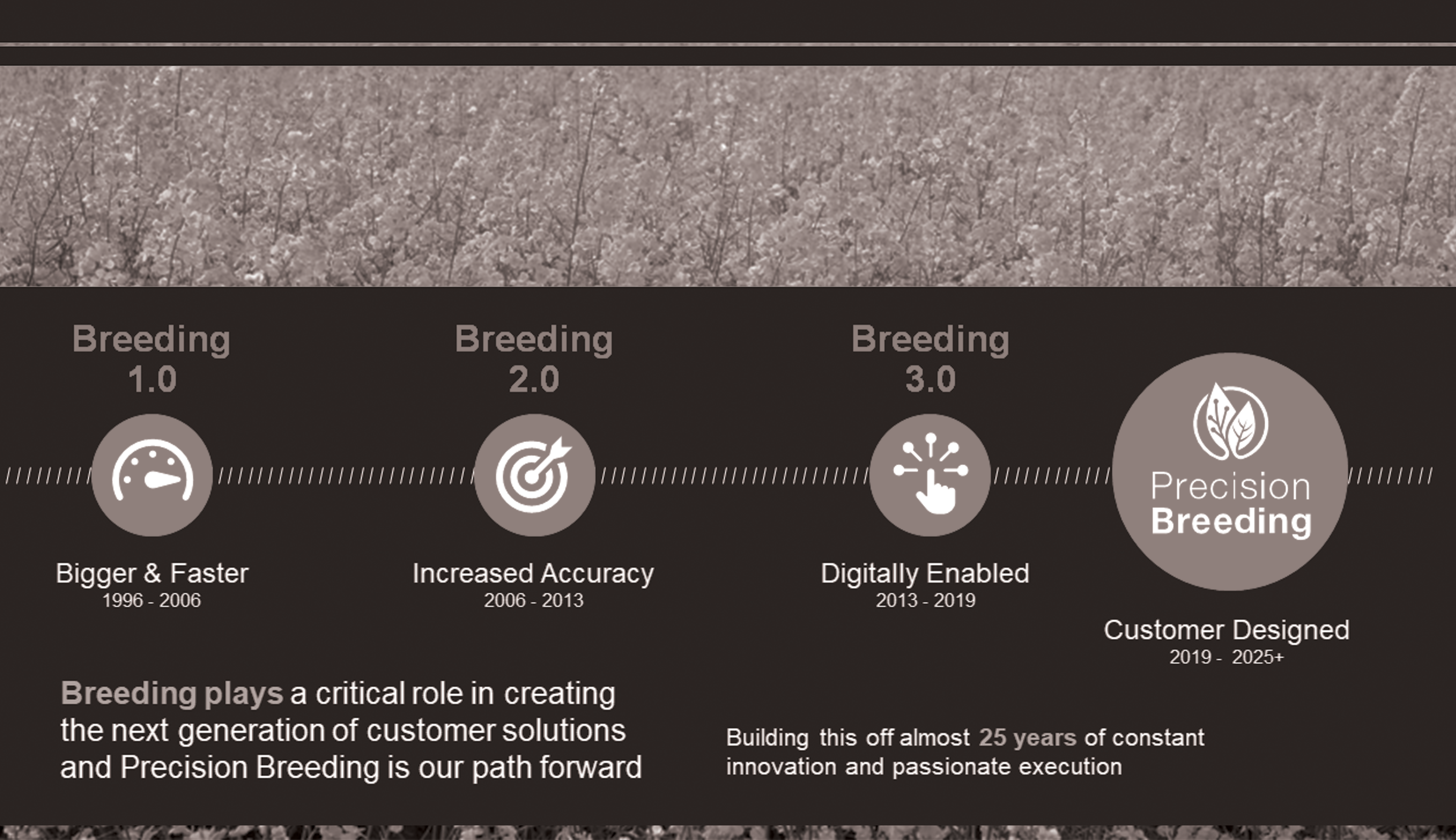Canola is an important crop for producing consumer and industrial oils (Figure 1). Canola breeders at Bayer are continually researching and evolving to develop and strengthen commercially available varieties that can fill the needs of canola growers and consumers who use the oil for cooking and industrial purposes. Figure 2 is a simplistic diagram for new product development. Canola breeders at Bayer use several breeding methods to develop new products. Historical and current breeding methods are discussed within this document.

Figure 1. Field of flowering canola.

Figure 2. Diagram for the development of new products.
Canola Breeding Processes
Canola History
Rapeseed was used by mankind for thousands of years for food and oil for lamps and other devices. However, historical rapeseed contained high levels of erucic acid, which is nutritionally undesirable, and glucosinolates, which are sulfur compounds that are responsible for the strong undesirable flavour of radishes, mustard, and other vegetables.1
During the 1960s and 1970s, rapeseed plant breeders in Saskatchewan and Manitoba, Canada began selecting and crossbreeding different rapeseed products to create a more desirable oil product for human consumption.1 Within ten to twenty years, the breeders' efforts resulted in rapeseeds with human-desirable food-grade oil (Figure 3). To differentiate these “new” desirable products from historical rapeseed, the name canola (Canadian oil) was trademarked and licensed by the Canola Council of Canada.1 Canola oil must have less than 2% erucic acid and less than 18 µmol (micromole) of glucosinolates per gram of air-dried oil-free meal.1
The development of commercially available canola products has evolved from open pollination to hybridization through conventional and genomic methods. The primary methods used today include crossbreeding, mutation breeding, and genomic selection.2 Open pollination was simply the planting of saved seed from the previous crop and replanting it from year to year.
Hybridization
Traditional crossbreeding methods involve the selection of different plants that may individually increase the beneficial qualities (such as oil quality, standability, disease resistance, and yield potential) of one of the plants. To accomplish the crossbreeding, the breeder determines which plant will be the male and which one will serve as the female based on the qualities the breeder wants to propagate. If plant A is determined to be the female, the male pollen producing structure or stamen is removed from plant A’s flower and the pollen from plant B (the male) is used to fertilize the female structure or pistil of plant A’s flowers. The resulting seed is harvested and replanted several times (referred to as F1, F2, F3, etc. generations) to produce a homozygous plant or inbred that carries the characteristics desired (may be the F7 generation plant). This inbred plant can be crossed with another inbred plant that went through the same process to get a canola variety with the desired characteristics. This process can be completed on potentially thousands of plants for the development of promising varieties. The varieties then go through extensive testing to determine the best of the best for commercialization. The complete process from the beginning to commercialization can be several years.
Conventional breeding efforts can be strengthened through mutation breeding. Mutations occur naturally within populations or can be induced with radiation, chemicals, physical means, and biological agents. The mutation may exhibit a desirable trait and can be introduced into other plants through conventional backcrossing.
Crossbreeding methods continue to be successful for new product development. However, a new product may have improved yield potential but may have lost a level of disease resistance, standability, or other factors during the breeding process. This is where the science of molecular engineering can help.

Figure 3. The oil from small canola seeds can be used for cooking and industrial purposes.
Molecular Breeding
Genomics and DNA (deoxyribonucleic acid) gene sequencing provides a method for breeders to select the best inbred plants effectively and rapidly for hybridization. Through DNA sequencing, breeders can determine if an inbred is carrying the desired characteristic without having to grow another generation. If the desired characteristic is absent in the DNA, the inbred can be discarded. Genomic science also provides the avenue for the development of herbicide tolerant varieties.
CRISPR
Within the last decade, CRISPR (Clustered Regularly Interspersed Short Palindromic Repeats) technology has become a means for the development of canola varieties and other crops with specific beneficial characteristics (palindromic means same from end to end such as an oak ladder is the same from end to end). CRISPR, a specialized area of bacteria DNA, has nucleotide repeats (ladder rungs) and spacers (space on each side of ladder between the rungs). The repeated nucleotides are the building blocks of DNA.3 The spacer repeats are copies of small pieces of viruses that have attacked the bacteria and are used by the bacteria to identify attacking viruses. Bacteria have an enzyme, Cas9, that can cut apart DNA. When a virus attacks the bacteria, the bacteria send the Cas9 enzyme into the cell to cut up and render the virus mute.4
The CRISPER/Cas9 mechanism can be used to edit the DNA by disabling or repairing a gene or inserting a new beneficial snip of DNA into the gene where Cas9 has cut the DNA.3,4 The CRISPR process is completed in a laboratory where a researcher uses RNA (a molecule that can read the genetic information in DNA) to accurately pinpoint the location on the cell nucleus where the editing is to be made.4 In the case of plants, the location to change may be the gene that controls standability. As an example, assume a canola breeder has determined that a canola inbred has the yield potential and disease tolerance desired; however, standability is questionable. The laboratory technician can cut out the standability gene in the poor standability inbred with Cas9 and replace the gene with an enhanced standability gene from another canola plant. The inbred now has the characteristics the breeder desires and can cross it with another inbred to create a new variety. CRISPR transformations are highly heritable; therefore, the time required to develop new products can be reduced. 3,4
To visualize CRISPR, think of the oak ladder again. Between each rung are spaces that look alike up and down the ladder and on each side. Now, imagine that one of those spaces has become rotten. The ladder is in good shape except for the one space. Being a good woodsman, you saw (Cas9) the rotten piece out, insert, and firmly attach a new piece of oak. The inserted piece of oak appears different; however, since it is from the same species of oak it carries the same basic genetic code as the cutout piece. The ladder is now repaired and can be used again.
Double Haploid
Another method for developing new canola varieties is through the Double Haploid (DH) process (Figure 4). Haploids are plants with a single chromosome set and DH plants are 100% homozygous with doubled haploids. The double haploid breeding process allows breeders to develop homozygous genotypes from heterozygous parents in one generation, which reduces development time dramatically. Double haploid plants are developed from one immature pollen grain (microspore) and doubled artificially to form homozygous diploids.5 Microspores from the flower buds of F1 plants are used to produce DH plants.6 Because each microspore produces a different homozygous plant, thousands of genetically different plants can be grown and evaluated through DNA sequencing for desirable traits within the first generation.

Figure 4. Diagram of double haploid breeding method which enables the acceleration of genetic gain.
Crop breeding continues to evolve, and Bayer is a leader in the development and utilization of new breeding methods. The diagram in Figure 5 provides a glimpse of how methods at Bayer have evolved to precision breeding which is based on the needs of the canola customer for products with high yield potential, disease resistance, improved standability, desirable oil concentration and quality, and other characteristics.

Figure 5. Evolution of Precision Breeding methods at Bayer Crop Science.
Sources:
1Casséus, L. 2009. Canola: a Canadian success story. Canadian Agriculture at a Glance. Statistics Canada. Catalogue no. 96-325-X.
2Ahmar, S., Gill, R.A., Jung, K., Faheem, A., Qasim, M.U., Mubeen, M., and Zhou, W. 2020. Conventional and molecular techniques from simple breeding to speed breeding in crop plants: recent advances and future outlook. International Journal of Molecular Sciences. Int. J. Mol. Sci. 2020, 21, 2590.
3Vidyasagar, A. 2018. What is CRISPER? LIVESCIENCE. https://www.livescience.com/58790-crispr-explained.html#:~:text=CRISPR%20technology%20is%20a%20simple,of%20diseases%20and%20improving%20crops.
4Saey, T.H. 2017. Explainer: How CRISPR works. ScienceNewsforStudents. https://www.sciencenewsforstudents.org/article/explainer-how-crispr-works.
5Khan, T.N. and Croser, J.S. 2004. Double haploid production. PEA Overview. Encyclopedia of Grain Science. https://www.sciencedirect.com/topics/agricultural-and-biological-sciences/doubled-haploids.
6Burbulis, N. and Kott, L.S. 2013. Application of doubled haploid technology in breeding of Brassica napus. 10.3 Doubled haploid method in breeding of Brassica napus. From Plant Genomics to Plant Biotechnology. Woodhead Publishing Series in Biomedicine. https://www.sciencedirect.com/topics/agricultural-and-biological-sciences/doubled-haploids
Other Sources:
Rowe, T. 2019. CRISPR in plant breeding. Creative Components. 238. Iowa State University. https://lib.dr.iastate.edu/creativecomponents/238.
Oplinger, E.S., Hardman, L.L., Gritton, E.T., Doll, J.D., and Kelling, K.A. 1989. Canola (Rapeseed) Alternative Field Crops Manual. Universities of Wisconsin and Minnesota. Accessed through Purdue University Center for New Crops & Plant Products. https://hort.purdue.edu/newcrop/afcm/canola.html.
Web sites verified 10/15/21
Legal Statements
Performance may vary from location to location and from year to year, as local growing, soil and weather conditions may vary. Growers should evaluate data from multiple locations and years whenever possible and should consider the impacts of these conditions on the grower’s fields.
Bayer and Bayer Cross are registered trademarks of Bayer Group. Used under license. All other trademarks are the property of their respective owners. ©2022 Bayer Group. All rights reserved. 2014_25166